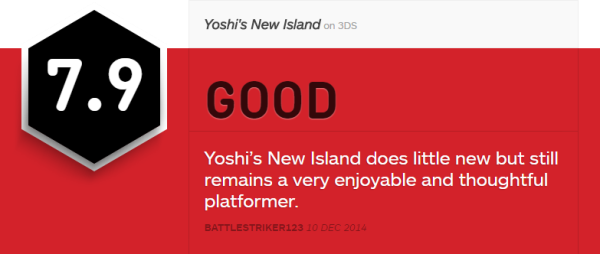Egg-sistential Crisis
Yoshi’s New Island is not really quite sure what it wants to be. While its many new ideas are strewn about the game’s six sizeable worlds, most of the game is a retread of what made the original Yoshi’s Island so unique – not that it is necessarily a bad thing, but it does make me question what exactly is so “new” about Yoshi’s New Island. Nevertheless, Yoshi’s latest adventure is a fun 2D platformer that stands well on its own, even if it does not reach the heights of the original. Some people will tell you that Yoshi’s New Island is inferior to the first Yoshi’s Island game in every way, and they would be right, but that does not mean this new game is not worth playing.
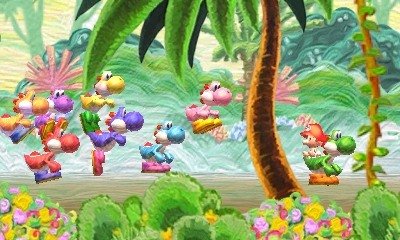
This looks... familiar.
The events of Yoshi’s New Island actually take place after the first game, when the stork that was responsible for delivering Baby Mario and Baby Luigi to their parents accidentally delivers them to the wrong house. En route to the right location, the stork is intercepted by Kamek and his baddies, who take Baby Luigi away to Bowser’s lair. Baby Mario, however, falls safely onto Egg Island – more accurately a planetoid floating above the Mushroom Kingdom; look, physics does not make any sense in Yoshi’s New Island, which you will hear about more below – where a secluded clan of Yoshi’s live. The rest is history; the Yoshi’s try to save Baby Luigi and the stork so that they can be delivered safely to their parents.
Gameplay in Yoshi’s New Island is similar to that of the other two Yoshi’s Island games. Players take control of Yoshi as he hops across precarious platforms collecting coins and flowers while avoiding enemies. Among Yoshi’s unique abilities are making eggs and throwing eggs; he can slurp up an enemy in front of him and transform the baddie into an egg, then with a press of the shoulder button can launch that egg as a projectile. This egg-throwing mechanic has a wide variety of different uses, among them eliminating other enemies, collecting coins, and activating winged clouds (which can either drop items or activate special events). Yoshi also retains his signature flutter jump, which allows him to stay in the air longer and get to hard-to-reach platforms.
One of the biggest parts of Yoshi’s Island is collecting. Each level has a set of missions to complete: retain thirty stars, find the twenty hidden red coins, and collect five flowers. Thankfully, there is no need to complete all three at the same time, and so players can pick and choose which ones to focus on each time they play a level. Collecting these items results in a whole bunch of unlockables, including single-player minigames and secret levels. Also available are two-player minigames that work with both single-card and multi-card play, though all of them seem tacked on and do not add anything substantial to the overall package.
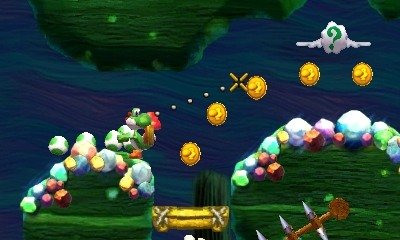
Yoshi's classic moves are still as useful as ever.
Key to Yoshi’s New Island is Baby Mario, who takes a more passive role in this game than in previous titles. If an enemy hits Yoshi, Baby Mario will fly off of Yoshi’s back and float away in a bubble. A timer will then begin to count down, and Yoshi must get Baby Mario back before the timer hits zero. Players can increase the time allotted to recapture Baby Mario by collecting stars, which can be collected from winged clouds or checkpoints. There are no longer exchangeable babies like in Yoshi’s Island DS though, so a lot of the mechanics in that game do not make a return in this one. This is a bit of shame though; as many problems as Yoshi’s Island DS had, the different babies added a unique twist to the Yoshi’s Island formula.
In fact, this lack of uniqueness is precisely Yoshi’s New Island’s main problem. About ninety percent of the game’s ideas are recycled from the first game, and very little of what is new to Yoshi’s New Island is integrated well with its core gameplay mechanics. The first four worlds have almost nothing new to offer, and some of the game’s level design decisions are blatantly lifted off of the SNES classic. It is not until the game’s final two worlds that Yoshi’s New Island begins to shine; one of my favorite levels is Chomp Rock Challenge, the first level in the sixth world, which forces the player to push rolling stones over moving platforms in order to narrowly dodge the hazardous lava floors. It may not be the most unique idea out there, but it certainly is creative. Unlike Yoshi’s Island DS, there is nothing particularly horrid about this game’s level design, though some stages do require a lot of patience to get through (more of a pacing issue than anything).
While the level design is fine, the boss fights in Yoshi’s New Island could use some work. Kamek will meet players halfway through each world, and her fights usually involve manipulating the room’s environments to suit the player’s needs. The main bosses at the end of each world range from rather impressive to extremely disappointing; the boss of the first world, for example, basically just sits around waiting for Yoshi to throw an egg at it, and does not really require any skill outside of making eggs and throwing eggs. There are more than several notable moments, however, especially in the game’s final few bosses, which show off some of the game’s stronger design choices.
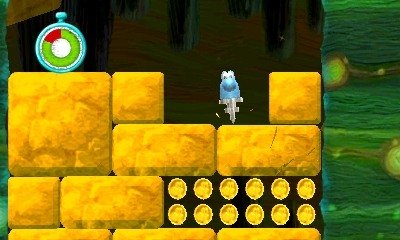
Transformations provide interesting diversions, but little more.
I do want to quickly talk about a few of Yoshi’s New Island’s new ideas. One mechanic prominently featured in the game’s many trailers are eggdozers – large, destructive eggs that are created by eating giant Shy Guys. There are two types of eggdozers: the regular eggdozer, which you can launch like a regular egg, and the metal eggdozer, which rolls around on the ground (and lets you dive underwater, which does not make any sense but okay). These events, however, are highly scripted, and add very little to the actual levels themselves. The same goes for Fake Yoshi’s, a new type of enemy that mimics Yoshi’s every move (and you must defeat him by leading him into a spike pit), but these sections only appear in bonus rooms and are seen just a few times throughout the game.
Yoshi’s New Island also makes a few changes to how transformations work. In the first game, transformation played an important role to completing many of its levels, and so skipping these sections was not an option. In this game, transformations are more or less optional; they act more like diversions from the main game, and are only required if you want to find all the collectibles in a given stage. These transformation rooms turn Yoshi into one of six different vehicles, and the player must complete them in a limited amount of time. These sections require that players use the 3DS’s motion control functionality to guide Yoshi around the game world, which can become unwieldy as these sections become more and more complex. Thankfully, the game is very lenient on the number of tries players get, and you can reattempt these transformation sequences as many times and you like.
There has been a lot of criticism among members of the media regarding the game’s presentation. Yoshi’s New Island looks like a mesh of multiple paintings from different artistic eras. Some stages, for example, have a distinct watercolor look to them, while others seem inspired by traditional Chinese ink washing. I like this range of different art styles because it adds a lot of visual variety to the game, and it does feel like Yoshi is traversing through a series of large paintings rather than designed levels. The 3D effect does well to separate these artistic layers from each other, and I found myself enjoying this eclecticism much more than I expected.
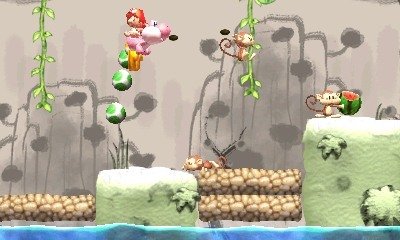
A blend of different art styles give this game a unique look.
Another common criticism about Yoshi’s New Island is its soundtrack. Admittedly, the game’s heavy use of kazoos and other children’s instruments is a bit jarring at first, but the soundtrack quickly grew on me thanks to the game’s very catchy main theme. Part of this may be because most of the soundtrack consists of different takes on the same melody, which does come off as a bit lazy, but there are some genuinely good tracks in here, especially in the game’s latter worlds.
Overall, there is not really anything wrong with Yoshi’s New Island other than the fact that it blatantly rips off content and ideas from the first game. Those looking for more Yoshi’s Island will find this game to be a solid entry in the series, while others looking for more innovative new ideas will leave being disappointed. In the end, there is much to like about Yoshi’s New Island, and although it is a bit difficult to give this game my full recommendation, there certainly is a market that will be very satisfied with this sort of experience.
